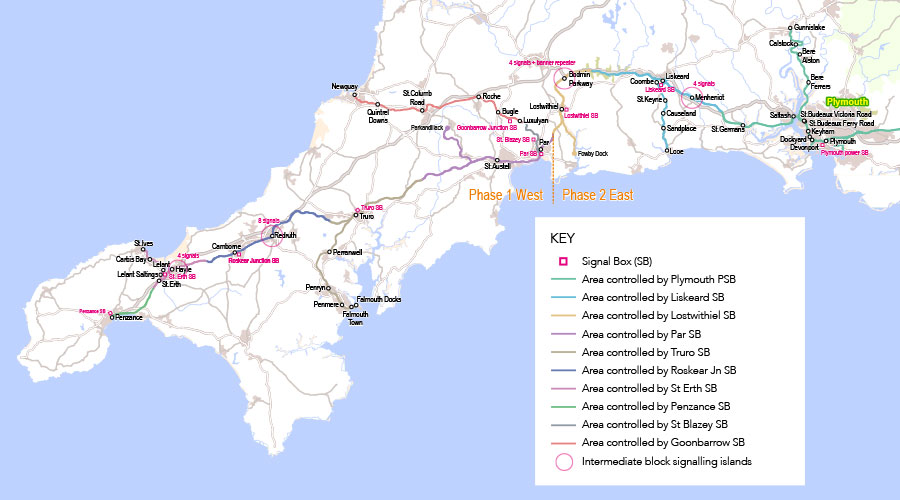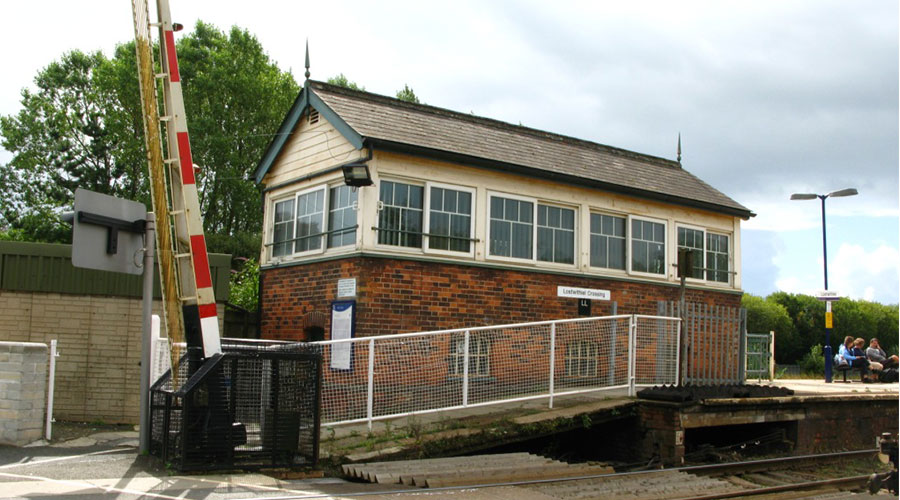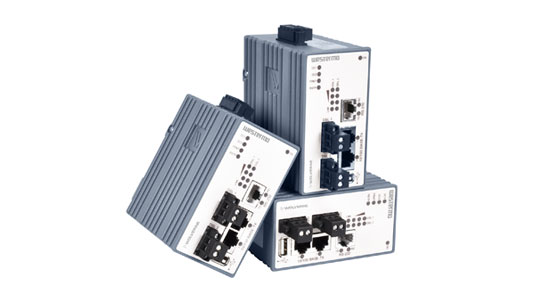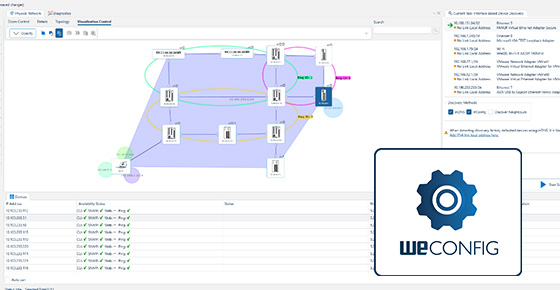Amey plc
Improved data communications in Cornwall
Resilient data communications network plays critical role in signalling upgrade project to increase train capacity in Cornwall
Westermo industrial switches help to ensure secure and reliable network performance across new Great Western Main Line signalling section
Application: Signalling system upgrade
Location: Great Western Main Line through Cornwall, UK
System integrator: Amey plc
End customer: Network Rail
Products: Lynx L110-F2G managed Ethernet switches and WeConfig network configuration manager
Britain’s railway infrastructure has undergone a period of significant investment and renewal. A number of extensive upgrade projects are being completed across the country, and data communications networks have a vital role to play in helping to ensure their timely and successful completion. Creating resilient data networking solutions that provide reliable and secure performance in the harsh environments of railway applications is one of Westermo’s core areas of expertise. Westermo has many years of experience in supporting mission-critical trackside and on-board rail projects, and in early 2018 its products and technologies proved crucial in the success of an important scheme to increase capacity on the Great Western Main Line through Cornwall.

With the number of railway journeys in Britain having doubled between 1998 and 2018, and passenger numbers predicted to increase by 40% by 2040 [1], the country’s rail network faces long-term capacity challenges. The Great Western Main Line’s route through Cornwall, down to its westernmost terminus in Penzance, is in particular need of capacity improvements, to encourage economic growth and tourism in the county. Helping to meet this challenge, Westermo has provided data networking technology to support the Cornwall Capacity Enabling Scheme (CCES).
CCES, part of Network Rail’s Railway Upgrade Plan, is a major two-phase signalling improvement project to increase the number of block sections on the main line, thereby making the sections shorter. To ensure safe operation, only one train at a time is allowed to pass within each signalling section, but the length of these blocks had been restricting the frequency of services. The first phase of the project, which was completed in May 2018, saw 20 intermediate block signals introduced, and six level crossings fitted with miniature signal lights (MSL), which allow users to see a green or red light to indicate whether it is safe to cross. As well as improving safety and journey reliability, the extra signalling will soon enable an increase in capacity, giving operators the capability to run one extra train per hour in each direction between Plymouth and Penzance when the new timetable is implemented in December 2018.
CCES was divided into two geographical areas, east and west, with rail infrastructure specialist Amey plc being awarded the design and build contract for the east area segment from St Germans to Lostwithiel. This part of the project included the introduction of a new signal section at Menheniot, in which the signals are controlled by a Westplex vital transmission system, and axle-counters are used to detect passing trains. About 50km of new communications cable was laid, and the Fixed Telecom Network (FTN) fibre network provided digital access to certain trackside locations.

Data communications plays a critical role in ensuring the safety, reliability and availability of railway operations. It was therefore vital for Amey to ensure a resilient and secure data networking solution for the new signalling section, and it consequently selected Westermo to provide its robust and compact industrial switches to be installed at trackside to securely manage the network’s data flow.
Because the data communications network is critical to the line operating safely, network redundancy is essential. This is provided via networking with a ring structure and Westermo’s patented FRNT protocol. This enables fast recovery of the network in the event of a fault, such as a failed device or cable, at any point in the network.
Westermo specialises in developing products that can function in the harshest environments and meet the most stringent approval specifications, and the Lynx L110-F2G Managed Ethernet Switches that were chosen for installation on the new signalling section are well proven in rail applications. The switches have been tested both by Westermo and external test houses to meet many electromagnetic compatibility, isolation, vibration and shock standards. The Lynx range has Network Rail acceptance and meets the requirements of the EN 50121-4 standard for trackside use, where typical challenges include wide temperature variations and exposure to electromagnetic interference.
The signalling architecture required the transmission of several functions over the FTN network, including axle-counter transmission of remote heads that could not be directly fed with paired cable, and transmission of vital Westplex functions between signalling buildings. The transmission of these functions was designed using Internet Protocol (IP) technology. This required Amey’s design team to provide an IP network from the trackside Signalling Relocatable Equipment Buildings (REB) to the nearest FTN transmission nodes. The use of fibre optic cables between the nodes and the REBs provided a path for routing the IP circuits over the FTN network to each of the other Signalling REBs and trackside assets within the project boundary.
Various switching technologies to provide the IP networking connectivity for the signalling circuits were evaluated by Amey, with Westermo’s being selected because of the switches’ proven robustness, high reliability, ease of configuration and long service life. Once the network design was approved by Network Rail, the Lynx switches were successfully tested to prove that their IP circuits would work across the Westermo equipment and across optical fibre connections. A point-to-point test was also successfully completed over an FTN Keymile testing rig, proving connectivity over the new FTN Keymile transmission equipment. The switches were then installed at each of the Signalling REBs at St Germans, Menheniot, Bodmin and Liskeard. Using the Lynx switches and fibre optic cables enabled the FTN layer 2 interfaces to be extended out to existing and new Signalling REBs. The IP network was then commissioned in April 2018.
The one-year timeframe for completing this section of the project was extremely challenging. Therefore, as well as the data networking technology having to be extremely reliable, it was also important to use equipment that would reduce complexity and help ensure that the project would be completed on time.
One area where valuable project time was saved was in device and network configuration. Traditionally, this would require a great deal of programming and coding, which would be both complex and time-consuming. However, the use of Westermo’s WeConfig network configuration management tool made network configuration more simple, efficient and reliable, saving many hours of work on initial installation of the network. Increasing reliability, WeConfig automates time-consuming routine configuration, minimising the risk of misconfiguration caused by human error, and reduces maintenance requirements. As well as supplying products and technology, Westermo also provided Amey with expert application advice and technical support throughout the duration of the project, helping to ensure that its section of CCES was finished on time.
Reducing the risk of unauthorised access to the network, WeConfig enabled the simple deployment of system-wide security features, while its security analysis functionality allows any network vulnerabilities to be found and fixed. After the Westermo devices had been configured and the network commissioned, WeConfig enabled a manual or periodic back-up of all the device configuration files to be easily made and stored. Lynx switches provide a long service life, with a mean time between failures of 630,000 hours, but in the event of a switch needing to be replaced in service, a rapid download of the saved configuration file onto a new device will result in a fast network repair.
[1] Network Rail Strategic Business Plan 2019-2024.

Layer 2 switches
The Westermo range of managed industrial Ethernet switches are designed for use in harsh environments and allow you to build cost-effective, reliable, secure networks.

Industrial network configuration tool
WeConfig makes network configuration and maintenance more efficient, simple and reliable. Many hours of work can be saved in the initial installation, as well as in ongoing maintenance throughout the life of the network.
Nuri Shakeer
International sales

For support inquiries, click here to contact Technical Support
